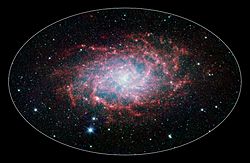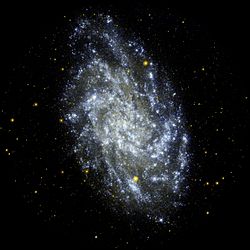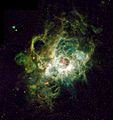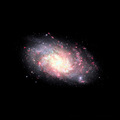Triangulum galaxy facts for kids
The Triangulum Galaxy is a spiral galaxy located about 3 million light years away from Earth. You can find it in the constellation called Triangulum.
This galaxy is the third biggest member of our "galactic neighborhood," which we call the Local Group. This group includes our own Milky Way galaxy, the Andromeda galaxy, and about 50 other smaller galaxies. The Triangulum Galaxy is one of the farthest objects you can see in the night sky without using a telescope!
Astronomers have given it a few names. It's known as Messier 33 (or M33) and also NGC 598. Sometimes, people call it the Pinwheel Galaxy, but it shares this nickname with another galaxy, Messier 101.
Contents
What is the Triangulum Galaxy?
The Triangulum Galaxy is a type of galaxy known as a spiral galaxy. This means it has a flat, rotating disk with spiral arms that reach out from its center. It looks a bit like a giant pinwheel spinning in space!
How Big is the Triangulum Galaxy?
The Triangulum Galaxy is quite large, but it's smaller than the Milky Way and Andromeda galaxies. It's the third-largest galaxy in our Local Group. Even though it's smaller, it still holds billions of stars, gas, and dust.
Where is the Triangulum Galaxy Located?
You can find the Triangulum Galaxy in the constellation of Triangulum. This constellation is named after its shape, which looks like a triangle. It's a great target for stargazers with telescopes.
Our Galactic Neighborhood: The Local Group
The Triangulum Galaxy is an important part of the Local Group. This is a collection of galaxies that are gravitationally bound together. Think of it like a cosmic family of galaxies!
What Galaxies are in the Local Group?
The two biggest galaxies in the Local Group are our own Milky Way and the Andromeda galaxy. The Triangulum Galaxy is the third largest. There are also about 50 smaller galaxies, often called dwarf galaxies, that are part of this group.
How Do Galaxies Interact in the Local Group?
Galaxies in the Local Group are all moving through space. They are also pulling on each other with gravity. Scientists believe that in billions of years, the Milky Way and Andromeda galaxies might even collide! The Triangulum Galaxy is also on a path that could lead to interactions with these larger galaxies.
Observing the Triangulum Galaxy
The Triangulum Galaxy is a fascinating object for astronomers and stargazers. Because it's relatively close and bright, it's a popular target for telescopes.
Can You See the Triangulum Galaxy Without a Telescope?
Yes, under very dark skies, away from city lights, you might be able to see the Triangulum Galaxy with your naked eye. It will look like a faint, fuzzy patch of light. This makes it one of the farthest objects you can see without any special equipment!
What Can Telescopes Reveal About the Triangulum Galaxy?
With a telescope, you can see more details of the Triangulum Galaxy. You might be able to spot its spiral arms, bright star-forming regions, and even some individual stars within it. Powerful telescopes, like the Hubble Space Telescope, can capture incredible images showing millions of stars and gas clouds.
Images for kids
See also
 In Spanish: Galaxia del Triángulo para niños
In Spanish: Galaxia del Triángulo para niños










